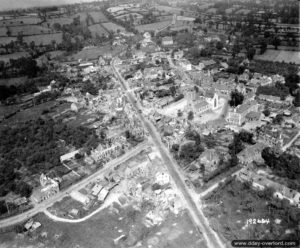Percy (Manche)
The cities of Normandy during the 1944 battles

- Liberation: 2 August 1944
- Deployed units:
![]() 115th Infantry Regiment, 29th Infantry Division
115th Infantry Regiment, 29th Infantry Division
![]() 110th Infantry Regiment, 28th Infantry Division
110th Infantry Regiment, 28th Infantry Division
![]() 803rd Tank Destroyer Battalion, 3rd Armored Division
803rd Tank Destroyer Battalion, 3rd Armored Division
![]() 2. SS Panzer-Division “Das Reich”
2. SS Panzer-Division “Das Reich”
![]() Panzer Lehr Division
Panzer Lehr Division
![]() 116. Panzer-Division
116. Panzer-Division
- History:
Before the fighting reached the town of Percy, it was occupied from July 20 by two Panzer Lehr regiments: Panzeraufklärungs-Lehr-Abteilung 130 and the 2nd Battalion of Panzergrenadier-Lehr-Regiment 902. Both units were temporarily withdrawn from the front to undergo a temporary reconditioning exercise.
Nearly a week later, starting on July 28, 1944, Combat Command A (CCA) of the 2nd Armored Division was tasked with conducting a breakthrough towards Percy. At the same time, the German 84th Corps intended to hold this sector to support the withdrawal of some of their troops south of the Cotentin Peninsula, trapped in the Roncey sector. They even intended to counterattack to slow the enemy’s advance and gain time for more reinforcements to reach Normandy. The Germans of the 2nd Panzer Division fiercely defended this sector and constantly harassed the road connecting Le Mesnil-Herman, Villebaudon, and Percy, unable to physically block it. They based their defense in particular on the unique terrain of the Soulles Valley, composed of steep, wooded slopes interspersed with hedges typical of the Normandy countryside. Artillery observers took advantage of this to guide fire, which proved particularly accurate. From the heights of Mont Robin, which peaks at 276 meters above sea level, they could observe the surrounding area for several kilometers.
That same day, reconnaissance vehicles from the CCA approached Percy from Villebaudon and reached the area known as La Guillerie. However, given the multiple attacks by the 2nd Panzer Division to the north, the advance was deliberately slowed to avoid isolating the American troops engaged further south. Starting on July 29, while the Americans were stationed a few kilometers north of Percy, the Germans received reinforcements from the 116th Panzer Division. They counterattacked on July 30 toward Villebaudon and reinforced their defensive position around Percy, with the contribution of survivors from the Panzer Lehr.
The 115th Infantry Regiment (IR) of the 29th Infantry Division, deployed to resume the action in the wake of the CCA, reached the outskirts of Percy with great difficulty, having been continually harassed by enemy artillery and armor. Sixty of their number were killed during that day alone, and the 803rd Tank Destroyer Battalion lost four of its M10 TD tanks while trying to detect enemy armor. The 115th IR took up position on the heights north of the village, near the place called La Cannière, unable to make further progress under German shelling. The regiment commanded by Colonel Alfred V. Ednie was to receive support from the 14th Armored Field Artillery Battalion, but a violent German attack held the artillerymen back in Villebaudon. This counteroffensive led to a change in the American posture: General Charles H. Corlett, commanding the 19th Corps, committed the 28th Infantry Division to maintain pressure on the German forces and maintain a steady pace of advance. The 110th Infantry Regiment overran the 115th Infantry Regiment.
Units of the 116th Panzer Division launched another desperate counterattack on August 1 to dislodge the Americans from the La Cannière sector, but without success. On August 2, unable to further hold their defensive positions in the village and its outskirts, the Germans abandoned Percy and retreated towards Le Chefresne, allowing the 110th Infantry Regiment to definitively liberate the town, two-thirds of which was destroyed.
Percy map:
![]() Back to the Normandy cities in 1944
Back to the Normandy cities in 1944
